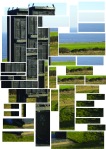For my Final Major Project on the Art and Design Foundation Course is Unnerving Animations. I came across this subject as I looked back at the animations and films that I enjoyed as a child and notice that not all of them were ‘ sunshine and butterflies’, some had unnerving and scary scenes in them. I decided to focus of the visual potential of mining these images and techniques, which may involve characters, settings and atmosphere. As well as looking into the style and methods that are used in these scenes and investigating what about makes them unnerving. Was it the visual features? Or was it the sound and music?
For my research I looked at a range of animations, film, short animations and artists whos work that an unnerving element to it. This included scenes from Dumbo’s Pink Elephants on Parade and Fantasia’s Night on Bald Mountain and The Socerer’s Apprentice both produced by Disney. The music element, visual and multiplying been key with in these clips. Short animations films such as Fear(s) of the Dark, Brian Andrews’ Hominid, Jan Svankmajer’s Alice a darker stop motion animation based on the book, A Short Vision created by Peter and Joan Folds, Robert Morgan’s The Cat With Hands and Raymond Briggs’ When the Wind Blows. I also looked into Japanese animation (Anime) and the Anime movie Akira, the reason for this is Anime is much more darker to our cartoons mostly because the characters, plot and added elements of politics, religion, humanity ect is so close to the real world and resulting in being much darker. I looked at the artists Fiona Rae and Takashi Murakami who’s work is cute, bright and fun but does have dark element to it such as adding third eyes, sharp teeth and repeating images until it gets too much. I also investigate the relation between sound and animation. From previous projects I have realised that audio helps the animation, for example a scary movie would not have the same effects without the sound and dramatic music. i research the sound and audio methods and tricks that horror and thriller movies take. From sound I looked at Janet Cardiff’s The Forty Part Motet which i saw at The Baltic Centre of Contemporary Art and was blowed away by it, how the sound surround you.
I collected existing animation clip that had unnerving elements to them and analysed them and mimed their style into drawings. I drew some hand drawn images, to help me get back into drawing as the animation that I want to make will be hand drawn.
From this I took a closer look at Disney’s Pink Elephants on Parade and decide to create a short animation based on the elephants heads with them changing expresses and colours as it goes on. I painted them on to acetates with acrylic paint because I wanted to try and recreate that dream-like quality of the animation and so that i could put the acetates onto black paper and take photographs of them. however this was problematic as the glare off of the acetates and the lighting stop me taking decent enough pictures. So in the end I scan them in, and added a black background in by using photoshop.
I aslo decide to create my own pink animals and similar to the elephants have a body part change into an instrument. i created a series of animations and hand drawn stills.
I continued to experiment with different ways of creating animations from ‘melting’ one images to another and repeating it, and Being inspired by Blu and William Kentridge using charcoal and paper, drawing a frame taking a photograph then rubbing it out before drawing the next frame.
I decided to look back at my artists and try and mime Murakami’ style. I took classic Disney characters such as TinkerBell, Winnie the Pooh ann Snow White and re drew them in Murakami style. I also redrew Woody Woodpecker and The Powerpuff Girls and create characters of my own. I really enjoyed this and I wished I could continue to draw and redraw classic characters. This inspired me to do more detailed traditional hand drawn animation using pencil and paper.
For my Final work I planed to create an animation inspired by Dumbo’s Pink Elephants on Parade scene, that it will start off slowly and gently and calm before getting more intense, colourful and hectic as it goes on before slowing down and starting all over again. My animation was made using a combination of my own animations that i made during development and existing footage. Layering them on top of another, multiplying clip, and filters on Final Cut. Using what I found from my images about bright colours, repeating and sound. It is just under 4 minutes long and has a separate sound track.
For the Final Exhibition it will be presented in a dark and dramatic (and specially created) viewing space. This space helps to dramatise the intensity of the animation which deliberately becomes too hard to watch.
NOTE: I WILL POST MY FINAL ANIMATION AT A LATER DATE, DUE TO NOT WANTING TO SHOW IT UNTIL THE SHOW THAT WILL BE NEXT WEEK. AS I WANT IT TO BE A SURPRISE FOR THE AUDIENCE.























































































































